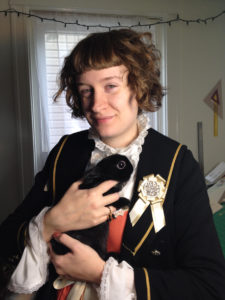 It’s always a treat to witness the beginning of a picture-book career, and that’s what’s happening with the author/illustrator we’re interviewing this month—Chicago artist Hannah Batsel, whose debut, A Is for Another Rabbit, comes out this month from Carolrhoda Books (Lerner Publishing). Hannah has a background in creating fine art and book arts, so she’s sure to have an interesting perspective on the process of becoming a picture maker. She’s also a self-described “fashion idiot and rabbit superfan.” Talk about intriguing!
It’s always a treat to witness the beginning of a picture-book career, and that’s what’s happening with the author/illustrator we’re interviewing this month—Chicago artist Hannah Batsel, whose debut, A Is for Another Rabbit, comes out this month from Carolrhoda Books (Lerner Publishing). Hannah has a background in creating fine art and book arts, so she’s sure to have an interesting perspective on the process of becoming a picture maker. She’s also a self-described “fashion idiot and rabbit superfan.” Talk about intriguing!
Let’s get to the interview to learn even more.
- Website: http://www.hannahbatsel.com/
- Instagram: https://www.instagram.com/hbatsel/
RVC: You probably don’t know this, Hannah, but I reached out to recent OPB-interviewee (and Lerner editor) Carol Hinz for suggestions on early-career writers who might be ideal for an OPB interview. Your name came up immediately—she clearly thinks you’re terrific. But here’s the real surprise—I already knew your name and work. You’ve got books in the Brizdle-Schoenberg Special Collections Center at my college’s library, and I lurk in there a lot.
Tell me about your interest in making special-collections-quality books like Ephemerus and Maneater, which are the two I’ve shown to my own students here.
HB: Wow, my reputation precedes me!
Well, I was first introduced to artist books and fine press books as a part of my printmaking studies, and I completely fell in love with them. I think that I’m a bit of a control freak, and the fact that I can write, illustrate, print, and bind an edition of books all by myself (and therefore obsess about whether that text line should be a sixteenth of an inch to the left or not for three days without annoying anyone else) is very empowering. Printing only small editions lets me branch out from the traditional codex structure and make weird double-sided books, books with jointed paper dolls, fold-out books that expand to twice their size—you name it! I think there’s a book design out there that’s perfectly suited to contain any conceivable human idea.
RVC: Let’s talk about my personal favorite—Maneater. It’s a boxed set of four books, where each sits inside the other like those Russian nesting dolls, and they’re held in place by little hidden magnets. And the story—if I recall it correctly—works backwards in time.
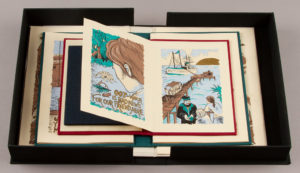 HB: It does work backwards in time—and then forward again! The smallest, innermost nested book takes place the furthest in the past, so as you read towards it, you get more context about the characters’ past relationships before having to read yourself back to the surface to finish the story in present day.
HB: It does work backwards in time—and then forward again! The smallest, innermost nested book takes place the furthest in the past, so as you read towards it, you get more context about the characters’ past relationships before having to read yourself back to the surface to finish the story in present day.
RVC: How did this project come about?
HB: This project was inspired by my collection of late-19th-century mass market colonialist children’s books (a mouthful, I know). These books’ covers are gilded and colorful and just a treat to look at, but their beauty belies a lot of frankly horrifying ideas about the Western world’s relationship with both the natural world and the cultures of people they didn’t understand.
The four books of Maneater are all illustrated in that lush and extravagant style, and each of the four books follows a different character. There’s a mythical tiger god who rules over life on a tropical island, an actual tiger who is captured from the island and sent to a zoo, a villager on the island who must emigrate and work at the zoo once the island is stripped of its natural resources, and a wealthy shareholder who ends up employing the zookeeper as a butler after a tiger attack forces him into retirement. The books can be read separately, but only when you read them together does a legacy of colonialist greed become clear.
RVC: In what ways are artist books like picture books?
HB: I would say that all of my artist books are picture books! They are certainly for an older audience, but every single page in them is illustrated. Like other picture books, they are meant to be held and explored and looked at, not just read. I even have an artist book that’s only pictures: Overhead, a book that I wrote, printed, and bound all on a commercial airline flight (confusing the flight attendants to no end, I’m sure.)
RVC: You earned a BFA in Printmaking and Book Arts from the University of Georgia, followed by an MFA in Interdisciplinary Book, Paper, and Print Arts from Columbia College Chicago. Clearly you had a book-focused future planned early on. When did you get interested in this career path?
HB: I had a professor at the University of Georgia who got me into artist books (thanks, Eileen!). Once it clicked for me that books could be made out of just about anything by just about anyone, I set out to do it in as many ways as possible. I feel fortunate to have found something that I can confidently say I’ll be making for the rest of my life in some form or another.
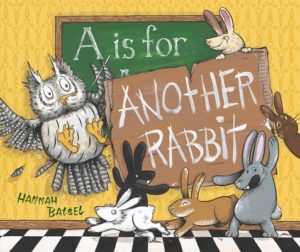 RVC: Let’s talk about your debut picture book. What’s the story behind A Is for Another Rabbit?
RVC: Let’s talk about your debut picture book. What’s the story behind A Is for Another Rabbit?
HB: I was speaking with my mom on the phone about how I’d like to write a children’s book, and how abecedaria (that’s nerd talk for “alphabet books”) were some of my favorites. I told her that I especially love animal alphabet books, but that I would probably want to make every letter about rabbits, which would make for a very boring book. We started goofing off and improvising pages (“U is for Uuuuuughh, seriously? Stop with the rabbits already!”) and while some of our off-the-cuff joke pages were a bit—well—vulgar for a younger audience, others did make it into the first draft of the manuscript.
RVC: How did the story change in the rewriting/revision process? Was it always metafiction from the first draft?
HB: Very little of the original manuscript ended up changing, actually! It was mostly minor tweaks. It was always metafiction; I think that with a format as tried-and-true as the alphabet book, the most interesting thing to do was to throw a monkey wrench into it and explore what would happen if this very rigidly-structured genre went awry.
RVC: Please talk a little about how you handle pacing via image and text.
HB: This is something that I tend not to think too hard about; rather, I draft out what feels best to me intuitively and then show as many people as I can so that they can tell me if something feels off. Pacing is one of those things that’s hard to get a grasp on if you’re too close to the project, so having outside perspectives helps a lot. In general, I try to keep my text as tight and necessary as possible—if I can cut something from a manuscript, I do!
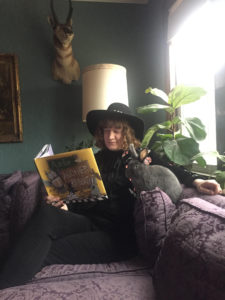 RVC: A Is for Another Rabbit uses rhymes, at times (yep—look what I did right there!). What’s your philosophy for rhyming well?
RVC: A Is for Another Rabbit uses rhymes, at times (yep—look what I did right there!). What’s your philosophy for rhyming well?
HB: Keep a consistent meter, jam as many rhymes in there as possible (not just at the end of the line), and above all else, use a rhyming dictionary! There’s no shame in it, and there are tons of free ones online; starting with a really great final line and then looking up rhyming words to build up to that finale is a great way to write a stanza.
RVC: The book is dedicated to “my favorite animal in the whole world: the rabbit.” What’s the appeal of these “feisty, fantastic, fluffy-tailed” critters?
HB: One little-known rabbit personality trait that I love is their sheer audacity, their absolute impudence. When a cat behaves like a jerk, at least he’s got the claws and teeth to back it up. A rabbit is a prey animal who has been running for his life in the wild for millennia, and yet you let him up onto your couch one time and he thinks he’s the king of the world!
The misbehaving rabbits in my book are inspired by a real rabbit, Pip, that I used to have. He was allowed to go anywhere in the house except for under my bed, so of course, he loved to try to sneak under when I wasn’t looking. Whenever I caught him snooping around for a way in, he would leap into the air with joy at the thrill of being caught and flee the scene! He seemed to like getting caught even more than succeeding!
RVC: I can sympathize with that because (when they were very little) my two kids loved to sneak into my office and riffle through my manuscripts, papers, stories, etc. and wait until I came back to catch them, and they’d laugh, laugh, laugh. Then they grew up and couldn’t care less what I do for a living.
What’s next for you in terms of the picture book world?
HB: I’m always working on my next book, and right now, I’m finalizing the manuscript and initial sketches for a new picture book that will make use of my letterpress-printing background. I can’t tell you much, but I’ll give you a hint: if A is for Another Rabbit is a good Easter read, this next one would be better suited for Halloween…
RVC: I look forward to the spooky fun!
Last question for the main part of this interview. Since Carol Hinz got you into this, what’s it been like working with her and Carolrhoda?
HB: Carol and the team at Carolrhoda have been an absolute dream to work with. Making your own books like I do means that I had no idea how a bigger production worked, which book sizes were standard, what to put on a title page, what a book contract looked like, or even… oops… how to accurately manage a final deadline. But Carol and Danielle Carnito, my art director, held my hand ever-so-patiently and walked me through the whole process.
One thing that’s a bit strange is that I’ve never met either of them in person! From start to finish, making a book together was a multi-year process, all over email. For all I know, Carol could be a bunch of rabbits standing on each other’s shoulders in a trench coat. Wait—have you ever met her?
RVC: Hold on now… while I’ve interviewed Carol, I have NOT met her. Hmmmm. You might be on to something here.
HB: I think so!
RVC: Alrighty—it’s time for the much-heralded, always-awesome SPEED ROUND. Rabbit-quick questions + hare-fast answers, please! Are…you…ready?!?
HB: I was born ready.
RVC: Your three favorite picture book rabbits?
HB: Wait, wait, I’m not ready!
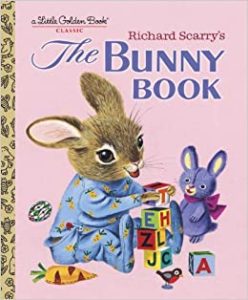 Uhhhh, jeez, this is a tough one! Honestly, Richard Scarry’s vast herd of fictional rabbits would probably take up all three slots. Naughty Bunny, The Bunny Book, Bunnies, I Am a Bunny, not to mention all of the Busytown buns—the guy’s practically cornered the market on great picture book rabbits! Honorable mentions, of course, for Margaret Wise Brown’s many picture book rabbits, especially those of Goodnight Moon and The Runaway Bunny!
Uhhhh, jeez, this is a tough one! Honestly, Richard Scarry’s vast herd of fictional rabbits would probably take up all three slots. Naughty Bunny, The Bunny Book, Bunnies, I Am a Bunny, not to mention all of the Busytown buns—the guy’s practically cornered the market on great picture book rabbits! Honorable mentions, of course, for Margaret Wise Brown’s many picture book rabbits, especially those of Goodnight Moon and The Runaway Bunny!
RVC: Most surprising rabbit fact?
HB: Rabbits can’t vomit. Hey, you asked for surprising!
RVC: Best place a rabbit might go to get GREAT Chicago deep dish?
HB: Pequod’s, hands down. That caramelized crust…
RVC: Best picture book art you’ve seen in the last year?
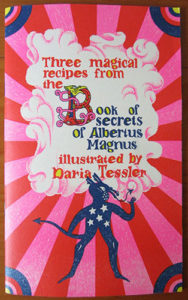 HB: Daria Tessler’s riso-printed zine, Three Magical Recipes from the Book of Secrets of Albertus Magnus, published by Perfectly Acceptable Press here in Chicago.
HB: Daria Tessler’s riso-printed zine, Three Magical Recipes from the Book of Secrets of Albertus Magnus, published by Perfectly Acceptable Press here in Chicago.
RVC: What’s going to keep you up tonight after doing this interview?
HB: Nothing. I can go to sleep within 15 seconds of hitting the pillow; it’s like a superpower.
RVC: Three things that are at the heart of your overarching creative vision?
HB: Magic, fine detail, and the exploration of power (and the power of exploration!)
RVC: From one Chicagoan to another, thanks so much, Hannah! It was a hoot cluck chirp uhhh, say…what sound do rabbits make?
HB: Hmm, well they do thump their back feet on the ground when they’re angry. But I think this interview has been more like a contented tooth-chatter, don’t you?
RVC: Right. That’s what I meant. It was truly a tooth-chattering swell time. Thanks for playing along, Hannah!


Hannah, I have enjoyed following your career through your (very proud) grandmother, Marge.
Your creativity is astonishing and I look forward to seeing many more amazing books.
It just now occurs to me that this is my first “fan letter.”